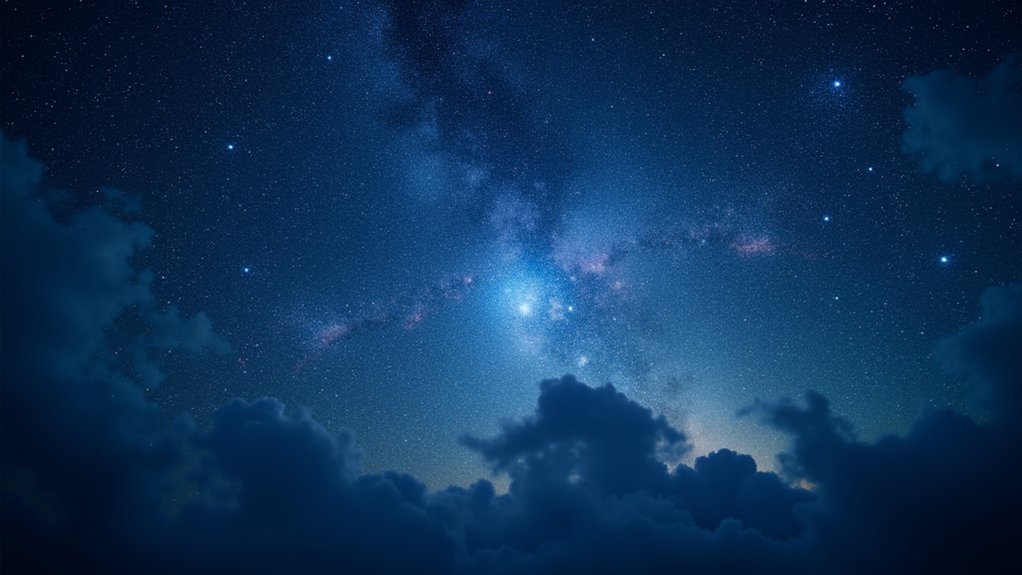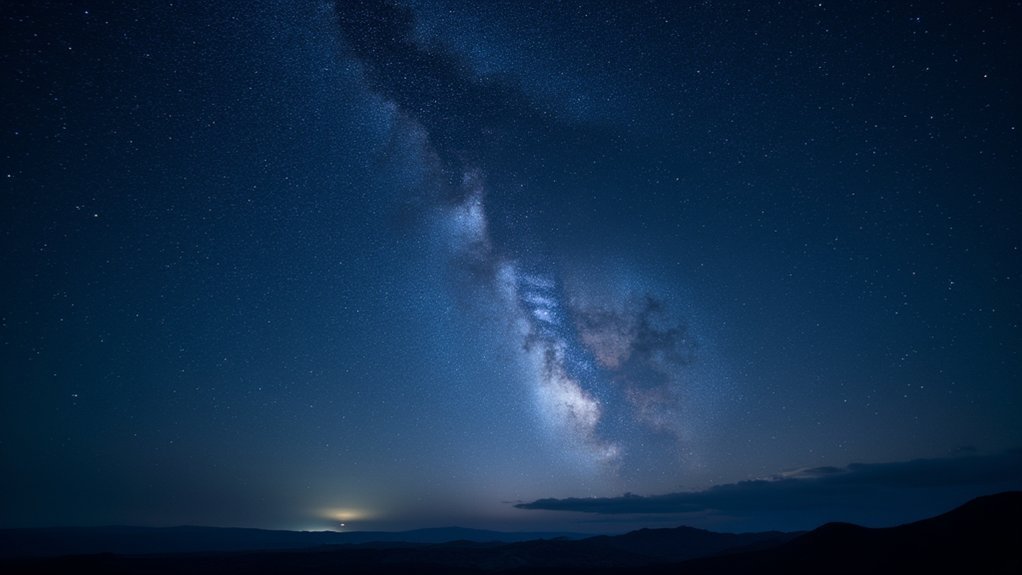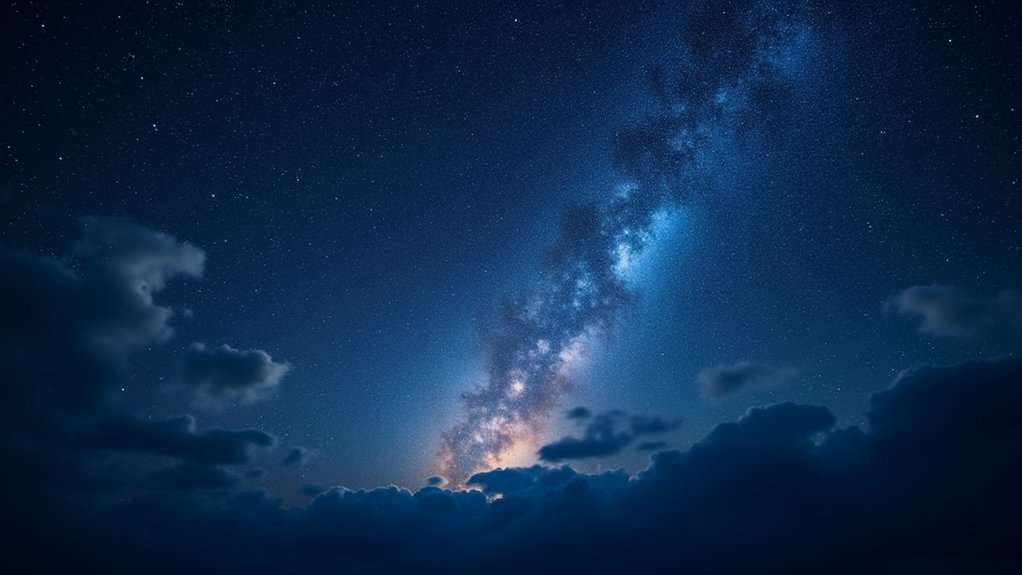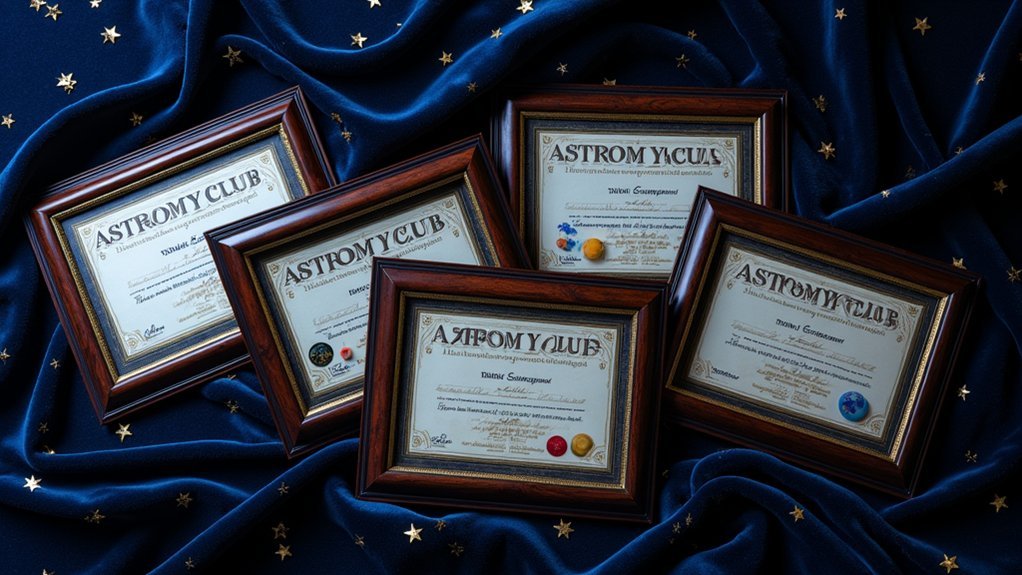Stars twinkle because Earth’s atmosphere distorts their light. As starlight travels through varying air densities and temperatures, it refracts and bends, creating rapid changes in brightness and color. You’ll notice more pronounced twinkling when viewing stars near the horizon, where light passes through thicker atmosphere. Weather conditions like wind and humidity also affect twinkling intensity. Understanding these atmospheric factors can help you identify ideal viewing conditions for your next stargazing adventure.
The Science Behind Stellar Scintillation

When you gaze up at the night sky, you’re witnessing stellar scintillation—the scientific term for the twinkling of stars. This phenomenon occurs as starlight travels through Earth’s turbulent atmosphere, where varying air densities and temperatures act like countless tiny lenses and prisms.
These atmospheric disturbances refract light waves, causing the rapid changes in brightness and color you observe. You’ll notice more pronounced twinkling when viewing stars near the horizon, as their light must navigate a longer path through the atmosphere’s turbulent layers.
Scientists measure atmospheric scintillation using specialized instruments called scintillometers that quantify light intensity variations.
Astronomers combat these effects using adaptive optics and larger telescope apertures, which help average out the distortions and provide clearer views of celestial objects.
How Earth’s Atmosphere Distorts Starlight
As starlight journeys toward your eyes, it must first navigate through Earth’s complex atmospheric layers, spanning roughly 10,000 km above the planet’s surface.
Starlight travels a celestial obstacle course through Earth’s atmospheric layers before reaching your wondering eyes.
These layers vary in temperature and density, causing light to bend and refract as it passes through.
When you observe stars twinkling, you’re witnessing astronomical scintillation. The turbulent atmosphere acts like countless moving lenses and prisms, constantly shifting the light’s path.
This effect intensifies when you’re viewing stars near the horizon, where light travels through more atmosphere.
The twinkling effect you see isn’t happening in space—it’s created entirely by Earth’s dynamic atmosphere. Air currents, convection, and temperature gradients all contribute to this shimmering display, making stars appear to rapidly change in brightness and sometimes even color.
Identifying Stars vs. Planets in the Night Sky

When you’re scanning the night sky, you’ll notice stars twinkle vigorously while planets maintain a steady glow, providing your first clue to identify celestial objects.
You can further distinguish planets by their position along the ecliptic and their typically brighter appearance compared to most stars in their vicinity.
The distinction becomes even more pronounced when viewing near the horizon, where atmospheric interference intensifies the twinkling effect of stars while planets remain relatively stable.
Telltale Twinkling Differences
Looking up at the night sky, you’ll notice that not all celestial objects behave the same way. Stars twinkle, appearing to flicker and change brightness as their pinpoint light gets distorted by Earth’s turbulent atmosphere.
Planets don’t twinkle because they appear as tiny disks rather than points, making their light less susceptible to atmospheric scintillation.
You’ll find this difference more pronounced when observing celestial objects near the horizon, where light travels through more atmosphere. In urban areas with light pollution, the twinkling effect often intensifies due to additional atmospheric disturbances.
To identify planets more easily, look for steady, non-twinkling lights along the ecliptic path—the invisible line planets follow across the sky.
On clearer nights, you’ll notice less dramatic twinkling overall.
Celestial Brightness Patterns
Brightness patterns offer another reliable method for differentiating between stars and planets in the night sky. When you observe celestial objects, you’ll notice planets maintain consistent apparent brightness, lacking the characteristic twinkle in the night that stars display.
This difference becomes especially pronounced near the horizon, where stars’ light travels through thicker atmosphere, intensifying their scintillation. In urban environments with light pollution, the twinkling effect of stars often becomes more noticeable, making identification easier.
Venus and Jupiter stand out with their steady, bright glow against the twinkling starfield. As you become more familiar with observing, you’ll naturally recognize planets as distinct disks rather than flickering points.
Remember that stars overhead twinkle less than those closer to the horizon, providing another contextual clue for identification.
Horizon Viewing Effects
The apparent twinkling of stars intensifies dramatically near the horizon, where their light must travel through a much thicker layer of Earth’s atmosphere. This atmospheric distortion creates a distinctive flickering effect that can help you distinguish between stars and planets in the night sky.
When you’re stargazing, especially in urban areas with light pollution, remember these key differences:
- Stars exhibit pronounced twinkling (scintillation) as their pinpoint light gets refracted through the atmosphere’s turbulent layers.
- Planets maintain steady brightness because they appear as tiny disks rather than points of light.
- The ecliptic path serves as a planetary highway where you’ll find non-twinkling planets against a backdrop of twinkling stars.
This knowledge transforms your viewing experience, allowing you to immediately identify celestial objects by their twinkling characteristics.
Atmospheric Factors That Intensify Twinkling

While stars themselves don’t actually flicker, atmospheric conditions on Earth create the beautiful twinkling effect we observe. This phenomenon occurs primarily due to atmospheric turbulence, where varying temperatures and densities of air layers refract starlight as it travels to your eyes.
You’ll notice more pronounced twinkling when viewing stars near the horizon, as light must travel through more atmospheric layers.
Weather conditions greatly impact what you see—wind patterns and convection currents create rapid fluctuations that enhance twinkling intensity.
If you’re in an urban area, light pollution can amplify this effect by altering the contrast between starlight and the background sky.
For clearer, less twinkling views, consider higher elevations where you’ll experience more stable atmospheric conditions with fewer disturbances to disrupt the light’s path.
Best Weather Conditions for Clear Star Viewing
Looking for the most spectacular night sky experience requires attention to specific weather conditions that dramatically reduce star twinkling.
When atmospheric conditions stabilize, stars appear sharper and more defined rather than flickering.
You’ll find ideal viewing during high-pressure systems when the atmosphere becomes especially stable. These conditions minimize the turbulence that causes twinkling and distortion:
- Low humidity environments reduce atmospheric distortion, allowing light to travel more directly to your eyes
- Cool, calm nights with minimal wind create stable atmospheric layers that decrease twinkling effects
- Rural locations away from light pollution let you see fainter stars that would otherwise be washed out
For the clearest views, plan your stargazing during cool, dry nights under high-pressure systems when the atmosphere remains most stable.
Regional Variations in Atmospheric Turbulence
You’ll notice dramatically different twinkling effects depending on whether you’re stargazing from mountains or coastal areas, with mountain locations typically offering steadier views due to thinner, less turbulent atmosphere.
Coastal regions often present more pronounced twinkling as temperature differences between land and water create additional atmospheric disturbances.
These regional variations follow seasonal patterns too, with winter mountain air generally providing the most stable viewing conditions while summer coastal evenings can produce the most dramatic twinkling displays.
Mountain Vs Coast Effects
Although both locations offer stunning views of the night sky, mountainous regions and coastal areas produce dramatically different star-twinkling experiences due to their unique atmospheric conditions.
When you observe stars from a mountain, you’ll notice more pronounced twinkling because the thinner atmosphere and dramatic temperature shifts create turbulent air currents that refract starlight unpredictably.
Coastal stargazing typically provides:
- More stable air masses with reduced atmospheric scintillation
- Less dramatic temperature variations, resulting in clearer stellar visibility
- Protection from turbulence due to consistent sea breezes
While mountains place you closer to the stars, the increased atmospheric disturbance can actually diminish your viewing quality.
Conversely, coastal areas may offer lower elevations but compensate with steadier atmospheric conditions that reduce the twinkling effect, potentially providing clearer astronomical observations.
Seasonal Turbulence Patterns
Seasonal variations add another layer to the star-twinkling phenomenon beyond geographical differences between mountains and coasts.
You’ll notice winter skies often display steadier stars as cooler temperatures create more stable atmospheric conditions with reduced turbulence compared to summer months.
If you live in coastal regions with frequent weather patterns, you’ll experience dramatic seasonal shifts in twinkling intensity as atmospheric turbulence fluctuates throughout the year.
Urban dwellers face particularly pronounced summer twinkling when heat radiates from city surfaces, creating turbulent air layers above.
Your location’s climate zone also matters greatly.
In tropical areas, you’ll typically observe more intense twinkling year-round due to persistent atmospheric instability, while temperate regions show more predictable seasonal patterns.
Higher elevations consistently offer clearer viewing with minimal twinkling, especially during seasonally stable periods.
Seasonal Changes That Affect Star Visibility
Throughout the year, you’ll notice dramatic changes in how stars twinkle as Earth travels along its orbital path.
These variations stem primarily from seasonal shifts in our atmosphere that alter how starlight reaches your eyes.
Winter brings colder, more turbulent air masses that intensify twinkling effects, while summer’s stable atmosphere allows for steadier viewing conditions.
The shifting seasons of spring and autumn create inconsistent twinkling due to rapidly changing weather patterns.
- Humidity fluctuations between seasons greatly impact atmospheric clarity, affecting how pronounced the twinkling appears
- Stars positioned low on the horizon twinkle more dramatically due to their light traveling through a thicker slice of atmosphere
- Seasonal temperature variations create different levels of atmospheric turbulence, directly influencing the intensity of twinkling you’ll observe
Tools and Techniques for Reducing Scintillation Effects
For amateur and professional astronomers alike, combating the effects of atmospheric scintillation remains a persistent challenge.
You’ll find that larger telescope apertures naturally reduce twinkling through aperture averaging, where atmospheric disturbances are averaged out across the wider collection area.
Modern observatories employ adaptive optics systems that dynamically adjust mirror shapes to counteract atmospheric turbulence in real-time, dramatically improving image clarity.
When these advanced systems aren’t available, you can still minimize scintillation effects using techniques like lucky imaging or speckle interferometry, which capture and combine only the sharpest frames from rapid-sequence photos.
For best results, plan your observations during nights with stable atmospheric conditions—avoid high winds and temperature fluctuations.
Professional astronomers often use scintillometers to quantitatively measure atmospheric twinkling, helping them select ideal viewing times.
The Role of Altitude in Stargazing Quality
When you venture to higher elevations, you’ll immediately notice the dramatic improvement in stellar visibility. The relationship between altitude and stargazing quality is straightforward: as you climb higher, you’re looking through less atmosphere, which means stars appear steadier and brighter.
The benefits of high-altitude observation include:
- Less atmospheric turbulence, resulting in reduced twinkling and better “seeing” conditions
- Decreased air density that minimizes light scattering and refraction
- Fewer moisture particles to interfere with your view, as thinner air holds less humidity
Mountain observatories leverage these advantages, which is why professional astronomers seek out high-altitude locations for their telescopes.
If you’re serious about stargazing, consider planning your next observation session at a higher elevation for a truly transformative experience.
Predicting Prime Viewing Nights Using Weather Forecasts
You’ll find the best stargazing opportunities when weather forecasts show clear skies with low humidity and minimal wind—conditions that reduce atmospheric turbulence.
Look for nights following cold fronts, when air masses stabilize and stars twinkle less dramatically.
For ideal viewing, consult astronomy apps that track both weather and light pollution forecasts, as they’ll help you identify those perfect evenings when the celestial display shines with minimal distortion.
Favorable Weather Indicators
Planning your stargazing nights strategically can greatly enhance your experience of twinkling stars. Look for favorable weather indicators such as high-pressure systems, which typically bring clear skies with minimal atmospheric interference. The most reliable conditions occur when humidity is low and cloud cover is absent.
For best stellar observation, target nights with:
- Stable atmospheric conditions marked by light winds and consistent temperatures
- Clear weather forecasts following high-pressure systems
- Low light pollution environments away from urban areas
You’ll find that timing your observations after periods of atmospheric stability rather than following thunderstorms or strong winds considerably improves visibility.
Stability vs. Turbulence
Understanding the battle between atmospheric stability and turbulence allows you to predict prime stargazing opportunities with remarkable accuracy. When you check weather forecasts, look for high-pressure systems that create stable air conditions with minimal atmospheric turbulence.
| Condition | Good Viewing | Poor Viewing |
|---|---|---|
| Pressure | High (stable) | Low (unstable) |
| Humidity | Low | High |
| Wind | Minimal | Strong |
| Temperature | Consistent | Fluctuating |
The less turbulent the atmosphere, the less stars will twinkle, providing clearer observations. You’ll find the most stable viewing conditions on nights with low humidity and gentle winds. Satellite imagery and local weather reports offer valuable clues about atmospheric stability patterns. By monitoring these indicators, you can identify nights when stellar objects will appear sharper with less distortion.
Photography Tips for Capturing Twinkling Stars
While photographing stars might seem challenging, capturing their mesmerizing twinkle effect requires specific equipment and techniques. The key to successful astrophotography lies in stability and light sensitivity.
Set up your tripod to eliminate camera shake during long exposures, which enhance the twinkling appearance. Use a fast lens with a wide aperture to collect more starlight and highlight brightness variations.
Stability unlocks the twinkling magic—pair a solid tripod with a light-hungry lens to reveal the stars’ natural shimmer.
For best results:
- Select a high ISO setting (1600+) to increase light sensitivity without introducing excessive noise
- Experiment with exposure times between 10-30 seconds to capture dynamic brightness changes
- Choose locations with minimal light pollution and clear atmospheric conditions for better visibility
These photography tips will help you document the ethereal nature of twinkling stars while avoiding unwanted star trails in your final images.
Frequently Asked Questions
What Causes the Twinkling of Stars?
You’ll see stars twinkle because Earth’s turbulent atmosphere refracts their light. As air pockets of varying temperature and density move, they bend the starlight, causing rapid changes in brightness and color.
In Summary
When you’ve learned why stars twinkle, you’ll never see the night sky the same way. Earth’s atmosphere transforms distant starlight into the shimmering jewels we love. You’ll spot planets by their steady glow, choose ideal viewing conditions, and know when to head for higher ground. With the right tools and techniques, you’ll capture breathtaking celestial images that showcase this beautiful atmospheric dance.





Leave a Reply